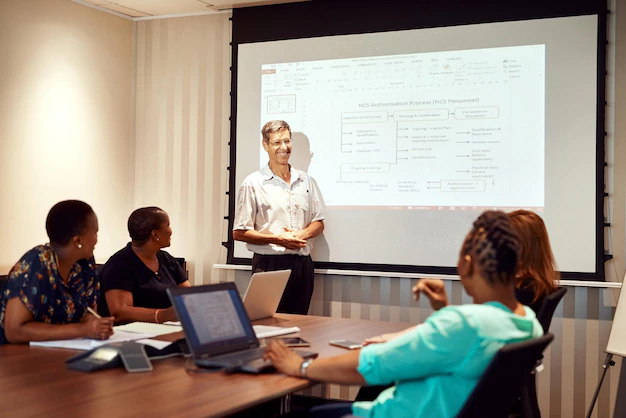How Can You Lead A Meeting Effectively When You’re A New Leader?
25 October 2022
4 Mins Read

toc impalement
Have you recently got a job as a leader, and you’re going to lead a meeting? If you are excited and nervous at the same time and don’t want to look unprofessional, then you must read this article.
Whether welcome or not, meetings are an inevitable part of the business world in almost every field and profession. Moreover, they may be fruitful and valuable if run efficiently. The problem is that most individuals don’t know what makes a good meeting. Therefore they seldom utilize meetings to their full potential.
The task of leading a meeting should not be frightening. A well-balanced framework, solid preparation, and timely execution are required. That will put you in a position of authority, making you the leader responsible for the most productive meetings in the workplace.
Why Should You Have A Meeting?
The most typical function of a meeting is to allow for direct communication between individuals. It might be anything: a novel concept, a challenging situation, a promising opening, a chance to think creatively, etcetera.
How Can You Lead A Meeting Effectively?
When it comes to internal communication, team meetings are only one option. However, they facilitate company members’ ability to share ideas and work together towards common objectives.
Attending a meeting is easy, but conducting one is far more challenging. It’s more work, so you’ll need more time and be ready for it. However, this is not all. Let’s discuss several easy-to-implement methods for leading over a meeting.
1. Plan and Prepare the Meeting Thoroughly

Find out why you need to get the group together before you start outlining and planning the meeting’s agenda. Assess the situation by asking yourself why a meeting is necessary. Try to find issues that benefit from group debate, clarification, or ideas from several people.
Suppose the meeting is particularly formal or important. In that case, you may wish to provide the agenda for the meeting so that attendees have time to prepare questions and take notes.
2. Keep the focus on Time Management during the meeting.
Starting and terminating the meeting at the specified time shows respect for your colleagues’ time and the time you place on their presence. Then, stick to the agenda you set up and postpone any follow-up questions or comments until the conclusion of the meeting.
Holding a meeting is important because it allows participants to debate issues at length, and brainstorming is a crucial part of this process. In addition, some of the finest ideas are developed via group discussion, so ensure everyone has time to speak out and contribute when appropriate.
The meeting’s time should not be wasted if just one subject is discussed. To avoid losing the interest of your team members, avoid becoming dull. A productive team meeting doesn’t have to go on for two hours. It has to be short since people’s time is valuable.
3. Share Valuable Information
Include action actions or desired outcomes to make the material from your meeting relevant to team members. Provide colleagues with the knowledge they can utilize to enhance efficiency, develop high-income skills, and achieve their objectives. Make it an objective for members to leave the meeting with some knowledge to assist them in their duties.
Introduce new technologies to your top managers to handle employee payments if the company is experiencing salary payment or financial crisis issues. For example, describe a real pay stub in which companies must keep their workers’ wages and taxes on file for a specific time.
4. Use Technology

Depending on how they are used, laptops and smartphones may facilitate or impede a meeting. For instance, participants should not use Facebook, check their email or browse the Internet. However, laptops may be beneficial for examining the agenda and supporting materials during a meeting.
Google Docs also provides a handy method to modify documents in real-time, allowing someone to retain a list of action items and meeting notes that all attendees can see.
5. Avoid Any Unnecessary Discussion
The ability to express yourself well in conversation is valuable; be careful not to over-explain. The participants in your meeting have many brains. There is no need to cover onboarding material at the first meeting if everyone is already aware of their duties.
If employees seem perplexed, it’s important to ensure they’re all right. However, you shouldn’t assume they have no idea how the business operates or what their jobs entail.
6. Allow Others to Speak
Some of your staff employees may feel uncomfortable raising their hands in a group setting, so be on the lookout for nonverbal signs that they want to share an idea. A timid worker, for instance, could start taking notes or shaking their head instead of speaking out.
During times, it’s helpful to have a different person speak at a meeting. Solicit updates on the project from those in charge. Allow the leaders of each division to present on behalf of their staff if you’re holding a meeting with numerous divisions.
7. Take Feedback

When you’re through with a meeting, it’s time to follow up with the attendees. It’s still a good idea to have everyone sign off on the meeting’s action items after verbally reviewing them after the gathering.
This is a crucial stage since it will reveal how well or poorly you prepared for and conducted the meeting. Incorporating your team’s suggestions into the agenda-planning feedback can result in more effective and fruitful future meetings.
Conclusion
Nobody likes sitting through meetings that consist mostly of lengthy discussions. They get in the way of productivity and make you feel like the organizer doesn’t value your time.
When meeting presenters spend time providing meetings with real value, participation increases organically. To expand on this concept, you may have an “attention-seeker” at the beginning of the meeting and assign individual tasks to everyone at the conclusion.
Read Also:


















Comments Are Closed For This Article